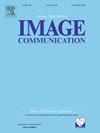Domain-guided multi-frequency underwater image enhancement network
IF 2.7
3区 工程技术
Q2 ENGINEERING, ELECTRICAL & ELECTRONIC
引用次数: 0
Abstract
The distribution of underwater images exhibits diverse due to the varied scattering and absorption of light in different water types. However, most existing methods have significant limitations as they cannot distinguish the difference between different water types during enhancement processing, and do not propose clear solutions for the different frequency information. Therefore, the key challenge is to achieve consistency between learned features and water types while preserving multi-frequency information. Thus, we propose a domain-guided multi-frequency underwater image enhancement network (DGMF), which generate high quality images by learning water-type-related features and capturing multi-frequency information. Specifically, we introduce a domain-aware module equipped with a water type classifier, which can distinguish the impacts of different water types, and guide the update of the model towards the specific domain. In addition, we design a multi-frequency mixer that couples Multi-Group Convolution (MGC) and Global Sparse Attention (GSA) to more effectively captures local and global information. Extensive experiments demonstrate that our method outperforms most state-of-the-art methods in both visual perception and evaluation metrics. The code is publicly available at https://github.com/liyoucai699/DGMF.git.

域制导多频水下图像增强网络
由于不同类型的水对光的散射和吸收不同,水下图像的分布也不同。然而,现有的大多数方法在增强处理过程中无法区分不同水类型的差异,对于不同的频率信息也没有明确的解决方案,存在明显的局限性。因此,关键的挑战是在保持多频信息的同时,实现学习到的特征和水类型之间的一致性。因此,我们提出了一种域引导的多频水下图像增强网络(DGMF),该网络通过学习与水类型相关的特征和捕获多频信息来生成高质量的图像。具体来说,我们引入了一个领域感知模块,该模块配备了水类型分类器,可以区分不同水类型的影响,并引导模型向特定领域更新。此外,我们设计了一种多频混频器,将多群卷积(MGC)和全局稀疏注意(GSA)相结合,以更有效地捕获局部和全局信息。大量的实验表明,我们的方法在视觉感知和评估指标方面优于大多数最先进的方法。该代码可在https://github.com/liyoucai699/DGMF.git上公开获得。
本文章由计算机程序翻译,如有差异,请以英文原文为准。
求助全文
约1分钟内获得全文
求助全文
来源期刊

Signal Processing-Image Communication
工程技术-工程:电子与电气
CiteScore
8.40
自引率
2.90%
发文量
138
审稿时长
5.2 months
期刊介绍:
Signal Processing: Image Communication is an international journal for the development of the theory and practice of image communication. Its primary objectives are the following:
To present a forum for the advancement of theory and practice of image communication.
To stimulate cross-fertilization between areas similar in nature which have traditionally been separated, for example, various aspects of visual communications and information systems.
To contribute to a rapid information exchange between the industrial and academic environments.
The editorial policy and the technical content of the journal are the responsibility of the Editor-in-Chief, the Area Editors and the Advisory Editors. The Journal is self-supporting from subscription income and contains a minimum amount of advertisements. Advertisements are subject to the prior approval of the Editor-in-Chief. The journal welcomes contributions from every country in the world.
Signal Processing: Image Communication publishes articles relating to aspects of the design, implementation and use of image communication systems. The journal features original research work, tutorial and review articles, and accounts of practical developments.
Subjects of interest include image/video coding, 3D video representations and compression, 3D graphics and animation compression, HDTV and 3DTV systems, video adaptation, video over IP, peer-to-peer video networking, interactive visual communication, multi-user video conferencing, wireless video broadcasting and communication, visual surveillance, 2D and 3D image/video quality measures, pre/post processing, video restoration and super-resolution, multi-camera video analysis, motion analysis, content-based image/video indexing and retrieval, face and gesture processing, video synthesis, 2D and 3D image/video acquisition and display technologies, architectures for image/video processing and communication.
 求助内容:
求助内容: 应助结果提醒方式:
应助结果提醒方式:


